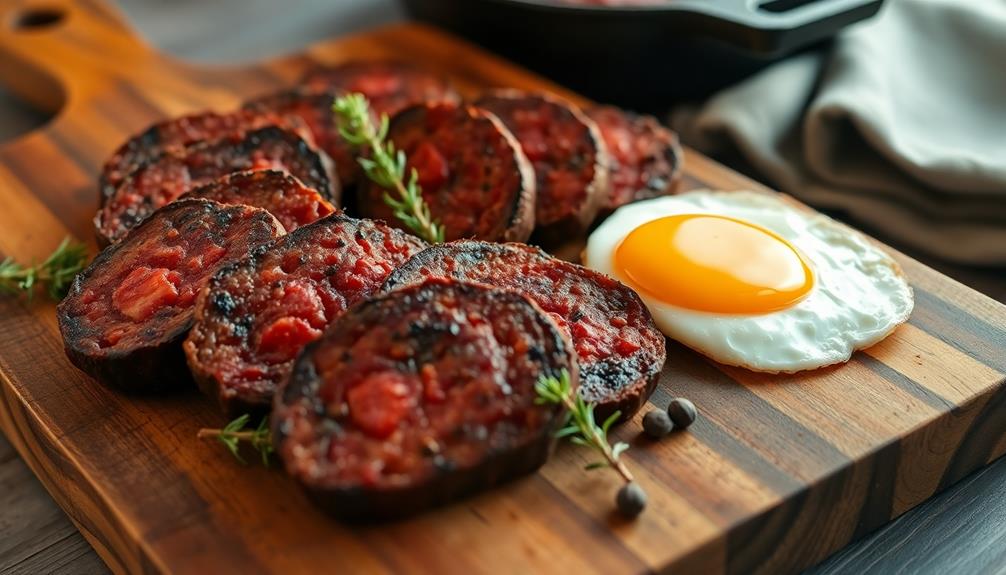Polish pierogi are traditional dumplings perfect for holiday gatherings. You’ll start with a simple dough made from flour, water, and salt, which you roll thin and seal tightly around your favorite fillings like potato and cheese or sauerkraut. Boil until they float or pan-fry for a crispy touch. These cherished favorites symbolize Polish comfort food and can be customized for any occasion—discover more ways to make your pierogi special as you explore further.
Key Takeaways
- Traditional Polish pierogi are made with a simple dough of flour, water, salt, and optional egg, filled with classic ingredients like potato and cheese or sauerkraut.
- Proper sealing and cooking techniques, such as boiling until they float or pan-frying, are essential for authentic texture and flavor.
- Pierogi are central to Polish holiday celebrations, symbolizing comfort, family, and festive tradition.
- Creative variations include fusion fillings from different cuisines, making pierogi suitable for modern holiday gatherings.
- Serving with accompaniments like sour cream, hot sauce, or chutney enhances their flavor for holiday feasts.

Pierogi are a beloved Polish staple that you’ll find on tables across the country, treasured for their delicious versatility and comforting flavors. These dumplings have a rich history rooted in traditional techniques, but that doesn’t mean you can’t have fun experimenting with new ideas. One way to update this classic dish is by exploring fusion fillings. Instead of sticking solely to traditional ingredients like potato and cheese or sauerkraut, you can get creative by blending flavors from different cuisines. Think spicy Thai-inspired fillings with lemongrass and chili, or creamy avocado and salsa for a fresh, modern twist. Fusion fillings allow you to personalize pierogi for any occasion, making them more than just comfort food—they become a statement of your culinary style.
When preparing pierogi with fusion fillings, it’s important to respect traditional techniques. Start with a good dough—flour, water, a pinch of salt, and some egg if you like—rolled out thin enough to hold your fillings without tearing. The process of sealing the dumplings is as crucial as the ingredients themselves, so pinch the edges firmly to prevent leakage during boiling or frying. Whether you prefer to cook your pierogi in boiling water until they float or pan-fry them for a crispy exterior, sticking to traditional methods ensures that you preserve the authentic texture and flavor that make pierogi so beloved.
While traditional techniques emphasize simplicity and harmony of flavors, trying fusion fillings invites you to balance contrasting tastes. For example, if you’re making a spicy Korean-inspired filling, you might want to add a touch of sweetness or acidity to counteract the heat. The key is to keep the dough neutral enough to complement the bold fillings, so avoid over-seasoning the dough itself. When sealing your pierogi, confirm there are no air pockets, as trapped air can cause the dumplings to burst during cooking. Once cooked, serve them with a dollop of sour cream, a drizzle of hot sauce, or a tangy chutney to enhance the flavor experience.
In the end, whether you stick to traditional recipes or venture into fusion territory, the essence of pierogi remains the same: a comforting, customizable dumpling that brings people together. Embrace the techniques passed down through generations, but don’t be afraid to add your own creative flair. By blending traditional methods with inventive fillings, you can elevate pierogi from everyday comfort food to a festive, memorable dish perfect for any holiday gathering.
Frequently Asked Questions
What Are Traditional Fillings for Polish Pierogi?
You’ll find that traditional fillings for Polish pierogi include savory options like mashed potatoes and cheese, which are classic in many recipes. You might also enjoy sweet fillings such as blueberries or strawberries for a dessert version. Using fresh ingredients, the pierogi dough surrounds these fillings perfectly, making each bite delicious. Stick to traditional recipes for authentic flavors, and don’t forget to serve them with a dollop of sour cream for added richness.
How Do I Store Leftover Pierogi Properly?
To store leftover pierogi, you should use proper freezing techniques. Place them in an airtight container or a freezer bag, separating layers with parchment paper to prevent sticking. When reheating, you can boil, pan-fry, or microwave them, ensuring they’re heated thoroughly. Freezing preserves their flavor and texture, while reheating methods help maintain their deliciousness without becoming soggy or dry.
Can Pierogi Be Made Gluten-Free?
Yes, you can make pierogi gluten-free by using gluten-free alternatives like rice flour, potato starch, or gluten-free all-purpose flour. Be mindful of cross-contamination concerns by preparing your dough separately and using dedicated utensils. You might need to experiment with ingredient ratios to get the right texture, but with these substitutions, you can enjoy delicious gluten-free pierogi that suit your dietary needs.
What Wines Pair Best With Pierogi?
When it comes to wine pairing with pierogi, you’re in for a treat that’ll bring out their best. A crisp Riesling or a light Chardonnay works wonders for enhancing flavors, especially with savory or cheese-stuffed varieties. For hearty or mushroom fillings, try a smooth Pinot Noir. These wines create a harmony that elevates each bite, making your pierogi experience truly unforgettable—like a perfect dance between food and drink.
Are There Regional Variations of Pierogi in Poland?
Yes, there are regional variations of pierogi in Poland. You’ll find different regional flavor profiles influenced by local ingredients, such as the hearty potato and cheese fillings in the south or the mushroom and cabbage fillings in the east. These variations reflect local culinary traditions and ingredient availability, giving each region’s pierogi unique tastes and textures. Exploring these differences lets you experience Poland’s diverse culinary heritage firsthand.
Conclusion
Now that you know how to make and enjoy pierogi, you’re ready to bring a taste of Poland to your table. These dumplings are like edible treasures, waiting to be filled with your favorite ingredients. Whether for holidays or everyday meals, they’ll create warm memories and delicious moments. So roll out the dough, get creative with your fillings, and let each pierogi become a tiny celebration—deliciously bursting with tradition and love.









